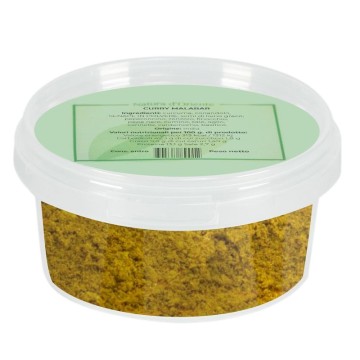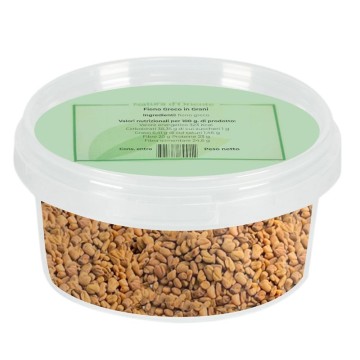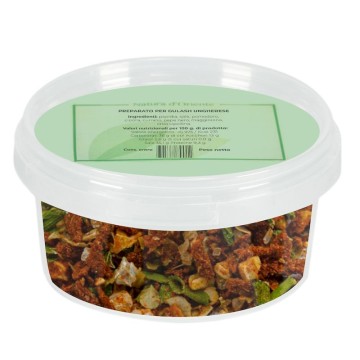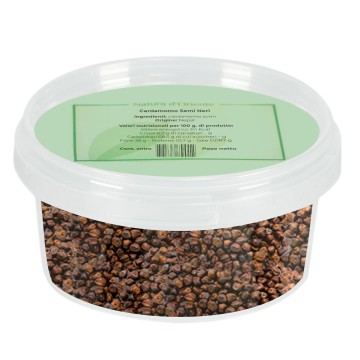This whole version of the turmeric bulb makes the most of its versatile use. It is a spice known for centuries for its beneficial and tasteful qualities, highly appreciated in oriental culture and cuisine. The turmeric plant, native to eastern India, lends its bright yellow-orange color to many dishes, and is one of the main ingredients in most curry powder blends. It was introduced in the Middle Ages to Europe, where it was considered "Indian saffron" or "yellow ginger" due to its similar color. It has recently become popular in the Western world due to its nutritional benefits.
Turmeric root: properties and benefits
This spice is known for its powerful antioxidant properties, due to its compounds called curcuminoids, the most important of which is curcumin - the main active element of turmeric. A diet rich in nutrients from turmeric can be useful for our well-being, which is why it is added to the daily diet of many people. A pinch of it is enough in everyday cooking to take advantage of its digestive and antioxidant qualities. Its known function, as a spice, is to promote digestion and liver function. It stimulates the gallbladder by helping the production of bile, which promotes better digestion and a reduction of air in the abdomen. For this reason it is useful as a natural remedy for the well-being of the intestine, relieving irritation. Except in the case of gallstones, where taking excessive turmeric could worsen the existing condition. It helps liver function with a purifying action on the liver, which supports the body in the process of expelling toxins. Returning to its compounds, turmeric can increase the antioxidant capacity of the body. It facilitates protection from oxidative damage, a process considered to underlie cellular aging and other health risks. Antioxidants are beneficial as they prevent free radicals from reacting in ways that are harmful to our well-being.
Curcumin, as a bioactive substance, is useful for joint function. The qualities of turmeric are beneficial for alleviating some symptoms of joint inflammation, osteoarthritis and rheumatoid arthritis. Furthermore, turmeric contains a substance known as lipopolysaccharide, capable of contributing to the well-being of the immune system. The use of the spice can also be useful to counteract menstrual cycle disorders and combat premenstrual syndrome. It can act on neurotransmitters to attenuate mood changes, and on digestive well-being to relieve menstrual disorders and cramps. Furthermore, turmeric is attributed with estrogenic activity (from phyto-estrogens) which could be useful for normalizing menstrual flow. The nutritional compositions of this spice also make it useful in cosmetics and aesthetics, in ancient times for hair dyeing and skin well-being. Among the properties of turmeric there are those that soothe the skin, as a natural remedy in case of irritation or to regulate excessive sebum production. The bright yellow color is due to curcumin, and is used for dyeing fabrics. The intake of turmeric up to 2-3 g per day is usually recommended if you want to use caution in consuming this spice. For good absorption, it is advisable to take it together with foods that contain healthy fats such as oils, avocados, nuts and seeds. To improve the absorption of curcumin into the bloodstream and enhance its effects, it is useful to consume it together with black pepper, which contains piperine - a natural substance that significantly increases the assimilation of curcumin. The combination of curcumin and piperine can also be useful for improving mood and stimulating metabolism. The spice is usually safe, but in some rare cases it can cause allergic reactions or interact with blood-clotting medications. It must be avoided in excessive doses in case of gallbladder pathologies. Stop taking turmeric if you notice any negative effects and consult a doctor.
Use of turmeric bulb in cooking
In the kitchen, turmeric is highly appreciated for its warm, not excessively pungent flavour, which is a bit reminiscent of ginger but with a more bitter and earthy note. It gives a delicate aroma with a slightly acrid note. This rhizome attenuates its aroma when cooked, while still spreading a unique spicy fragrance in many Indian and exotic dishes. It spreads its yellow color on dishes, and for this reason it is also appreciated as a garnish in recipes. The pigment component is concentrated, so that's itadd a teaspoon (1/8) to the dish to obtain a bright yellow colour. Too much can give food a dark yellow, “muddy” color. The dried bulb version of turmeric is tastier than the fresh one, but can still be dosed better than other spices: its flavor is not as strong even in significant quantities. As a root it can be chopped or grated in recipes, as you would ginger.
International cuisine: It is used in all Indian meat and vegetable dishes, and particularly as an ingredient in spice blends. In other regions such as Indonesia and North Africa, turmeric is famous in the preparation of colored and flavored rice pilaf. In a typical Balinese recipe, ground turmeric is mixed with coconut milk and lemongrass to season the rice.
Savory recipes: the condiment with turmeric is becoming increasingly popular to flavor soups, soups and rice. The pungent taste is excellent on roasted vegetables and egg dishes, it makes a unique flavor in cheeses. It is used to prepare vegetarian and vegan recipes with tofu, legumes and vegetables. Meat: highly appreciated in meat stews, it can be used both in the preparation and grated at the end of cooking to give a special flavor to meats, from chicken to red ones. It can flavor meatballs, stews, meat rolls; for the seasoning, dissolve the turmeric in the hot broth. Turmeric is also used for fish soups or recipes such as boiled cod.
Colour: Turmeric is used industrially as a colorant for mustard, as well as for certain cheeses and liqueurs. Baked products: turmeric is a coloring and flavoring ingredient for bread, taralli, breadsticks, focaccias. It is also used for sweet products such as muffins, cakes, creams, puddings, biscuits. Drinks: excellent for preparing drinks such as golden milk, smoothies, centrifuges, fruit juices; useful for flavoring herbal teas and infusions. The turmeric infusion is obtained by inserting ½ teaspoon of ground turmeric into a boiling cup (you can add a few grinds of black pepper) and leaving it to infuse for about 5 minutes. Mixtures: it is one of the main ingredients of Indian curry and other Middle Eastern spice mixes. Sauces: Turmeric can add an exotic touch to sauces, sweet and sour chutneys, vinaigrettes, mayonnaise and vegan dips. It can also be added to tomato sauces and in combination with honey. A smaller amount of dried turmeric is used to replace fresh turmeric in recipes. The doses are often halved, given that the drying process concentrates the turmeric to a considerable extent (e.g. 1 teaspoon of fresh turmeric becomes half a teaspoon of dried turmeric bulb).
Braised lamb in spiced yogurt sauce
Ingredients: 4 lamb shanks - 2 tablespoons of salt - freshly ground black pepper - 1 large piece of fresh ginger, peeled and chopped - 8 cloves of garlic, peeled and chopped - 500 ml of cold water - 8 tablespoons of olive oil - 2 tablespoons of cumin seeds - 1 tablespoon of cloves - 4 cinnamon sticks - 2 tablespoons of black peppercorns - 475 ml of whole yogurt - 4 tablespoons of ground coriander seeds – 1 and ½ teaspoons of coarsely ground chilli pepper - ½ teaspoon of ground turmeric
Preparation Preheat the oven to 160°C for the lamb shanks Season the shanks by applying on the entire surface ½ teaspoon of salt and freshly ground black pepper to taste, according to taste. Blend the garlic, ginger and four tablespoons of water until smooth. Set aside. Take a large non-stick baking tray, suitable for the oven and with a leak-proof lid. Add the oil and heat it over high heat until smoking. Add the lamb shanks and fry for 3-4 minutes, turning occasionally, until lightly browned on all sides. Remove the shanks from the pan and set aside on a warm plate. Add the spices to the pan where you cooked the shins in the hot oil: cumin, cloves, cinnamon and peppercorns. Sauté for 10-15 seconds, until fragrant. Add the ginger-garlic paste, mixing well. Fry everything for 4-5 minutes or until lightly browned. Remove the pan from the heat and let the mixture cool, then add the yogurt and stir until combined. Then add the remaining water and continue mixing to bind the ingredients. Return the pan to the heat, then add the ground spices: coriander, chili pepper, turmeric; add the remaining teaspoon and a half salt. Mix welluntil everything is mixed together. Return the lamb shanks to the pan, so that they are coated in the yogurt and spice mixture. Bring the mixture to a boil, then cover the pan with aluminum foil and place the lid on. Transfer the pan to the preheated oven and cook slowly for three hours, turning the shanks every 30 minutes. Once the necessary time has passed, remove the pan from the oven, remove the lid and the aluminum foil. Place the pan over high heat to bring the yogurt mixture to a boil. Reduce the heat until the mixture begins to simmer, then simmer the remaining liquid for 6 to 7 minutes, or until the liquid has reduced and the sauce has thickened. Baste the lamb shanks regularly with the unreduced sauce during slow cooking. Once cooked, let it warm and serve, you can accompany it with basmati rice.
Origins and history of cultivation
Curcuma longa is a flowering plant from the Zingiberaceae family, the same as ginger. It gives the famous spice through its rhizome (underground root). This perennial plant is native to the Indian subcontinent and south-east Asia, and in fact requires a warm climate for its development. Turmeric has been known in Indian culture for about 4000 years, a time when Indians made extensive use of the spice. It was considered fundamental to Hindu religious rituals given its yellow coloring power, linked to the sun. Even the clothes of Buddhist monks were dyed by hand with turmeric, as were the cosmetics used for weddings and holidays (it dyed brides' hair). Even today, India is the world's leading producer of this tropical root which, when grated, produces the famous "gold dust". In addition to its culinary and ritual uses, turmeric was also very important for its therapeutic virtues in Ayurvedic medicine, and later in Chinese medicine (turmeric reached China in 700 AD). Its anti-inflammatory power for the time was used for various treatments - from cardiovascular problems to arthritis, up to use as a uterine tonic. In Europe the plant was introduced in the Middle Ages by sailors and merchants on other continents. In Africa since 800 AD and in Europe it is found in medieval monastic writings. Due to its similar color to saffron, it was also mistakenly mistaken for this spice - in the thirteenth century Marco Polo described this spice, marveling at the qualities so similar to those of saffron. It reached America and Jamaica in the 18th century.







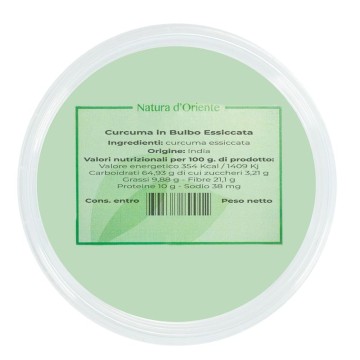

 No reward points for this product.
No reward points for this product.

